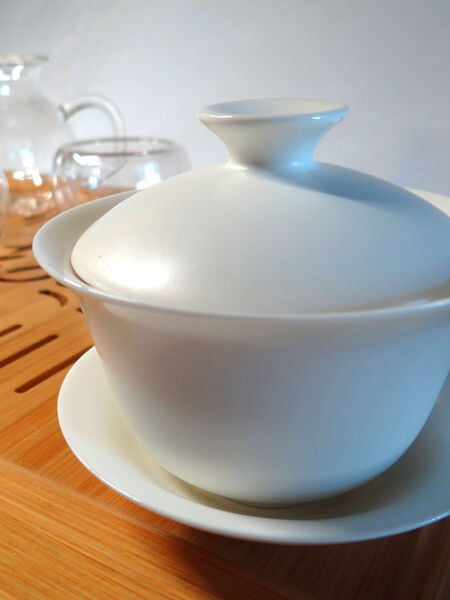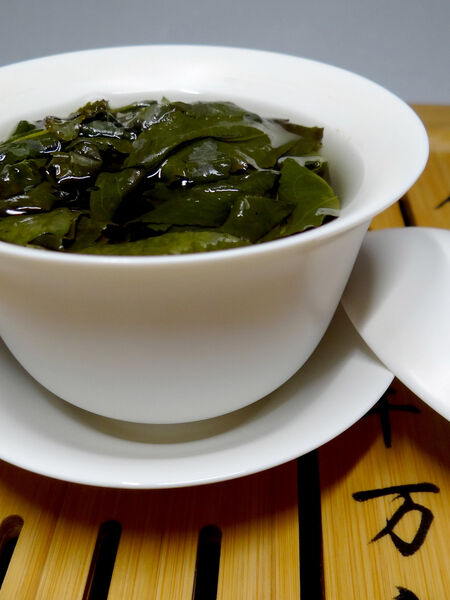How to Brew Tea the Gongfu Way


Everyone who begins their tea journey embarks on a quest to brew the perfect cup of tea. If you’re looking for a contemplative method of tea brewing that gives you a perfect cup of tea, the Gongfu Tea method may be what you’re looking for. Gongfu Tea (also known as Kung Fu Tea as in the martial art) is a Chinese method of brewing tea that involves brewing in smaller vessels with a higher leaf to water ratio: the same leaves can also be brewed multiple times. Gongfu tea allows the brewer more control over the tea brewing process, creating the perfect cup of tea made to the preference of the sipper.
What Tools Do I Need?
One of the key items of Gongfu Tea is the brewing vessel where brewing occurs, usually a small teapot or a Gaiwan (or lidded bowl). Using a smaller tea vessel means there is a higher ratio of leaves to water during the brewing process, shortening brew times, producing a flavorful cup, and allowing for multiple infusions. Both Gongfu teapots and Gaiwans come in porcelain or unglazed Yixing (which is a special clay that absorbs tea flavors). Porcelain is easily accessible to beginners of Gongfu tea, while Yixing tends to be favored by long time connoisseurs. Some teapots and Gaiwans come with a couple of teacups in matching material, which are usually small and handleless.
In addition to a brewing vessel and teacups, a separate pitcher and tea tray are recommended for the true Gongfu experience. The pitcher, whether one designed specially for Gongfu or even one used for cream in restaurants, is used to halt the brewing of tea in the teapot and hold the tea before serving in the teacups. The tea tray is a wooden tray with slits or holes on top and a reservoir underneath to catch water. The tray makes it easy to discard unneeded water but can be substituted with a bowl.
There are other optional accessories for Gongfu tea, including a strainer (which will catch any stray leaves between pouring from the teapot to the pitcher), a towel or cloth to wipe teacups off before serving, tea tongs (wooden tongs used to handle teacups without touching them), and a tea pet (a porcelain animal which tea is poured on top of).
What Type of Tea Should I Brew?
While almost any type of true tea can be brewed using the Gongfu method, the process is designed specifically for Chinese or Taiwanese teas. Black, Oolong, Pu-Erh, White, and Green teas can be brewed using the Gongfu Tea method: simply follow the conventions for brewing temperature for each tea type. Herbal and flavored teas are not recommended for Gongfu Tea. Teas with big, unbroken leaves provide the best flavor: Ti Kuan Yin, Keemun, or Yunnan teas are some of the most popular choices.
Author’s Note: I’ve had good luck brewing Gongfu Tea with various kinds of Chinese teas including Gunpowder, Ti Kuan Yin, and Silver Needle. Teas scented with jasmine also brew nicely with Gongfu. Oolongs in particular brew quite nicely, but can expand as more brewings occur; future brewings may have less water than earlier ones.
How to Brew With the Gongfu Method
While there are twenty-one official steps to the Gongfu Tea Ceremony, most people who brew tea the Gongfu way don’t strictly follow those steps. The goal of Gongfu Tea is to brew the best possible tea and extract the right flavors. The basic process is as follows (and can be adjusted):
1. Warming the tea vessels. With teapot, pitcher, and teacups on a tea tray, pour hot water into the empty teapot or Gaiwan. Pour additional hot water into pitcher and teacups: don’t worry about how much goes into the pitcher or cups. Pour the water from the teapot into the pitcher, and then pass the water from the pitcher into the teacups until the teacups are full. Discard the remaining water in the pitcher into the tea tray. With a pair of tea tongs (or simply lift them with your hand), pour the water from the teacups into each other, passing the water down the line: any overflow will be caught by the tray. Finally, discard the water from the last teacup into the tray. All the tea vessels have been warmed.
2. Rinsing the Tea Leaves. Measure the tea leaves and pour into the teapot. Pour water into the teapot and close the lid. Immediately pour the water into the pitcher with a strainer, and then pour the rinse into the teacups. Empty the teacups into each other as in step one, and discard the rinse into the tray. While you’re doing this, the leaves in the teapot are keeping warm and releasing their aromas.
3. Brewing the Tea. Pour water into the teapot and allow the tea to brew (about 20-30 seconds). As in step 2, pour the tea into the pitcher with the strainer, and then pour the tea evenly into the teacups. Serve the tea (either with your hands or a pair of tea tongs), wiping excess water from the bottom of the cups and serving guests first before yourself. Enjoy the tea. Repeat this step for subsequent brewings (anywhere from 4-8 times or until the flavor fades).
